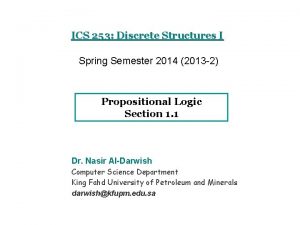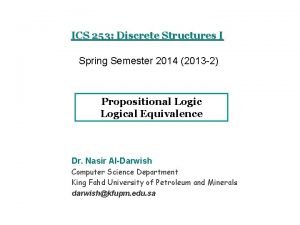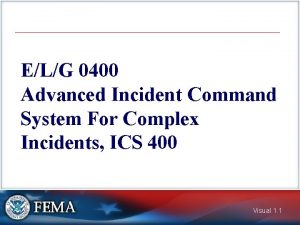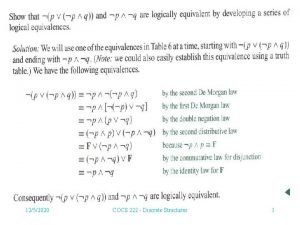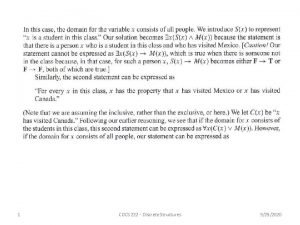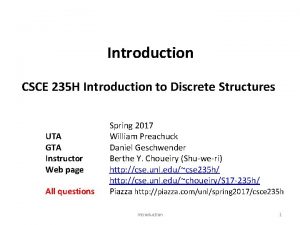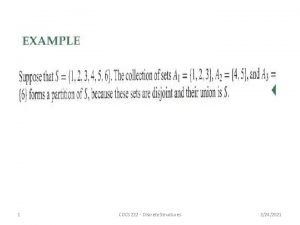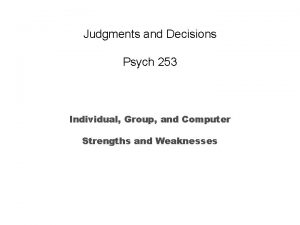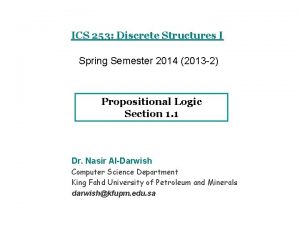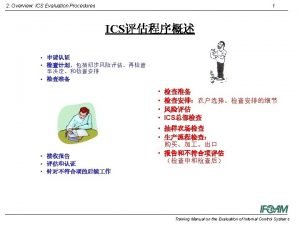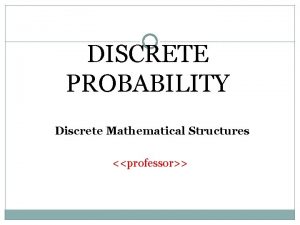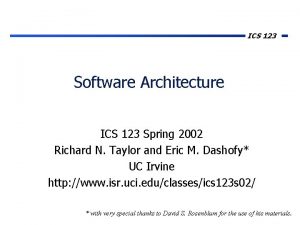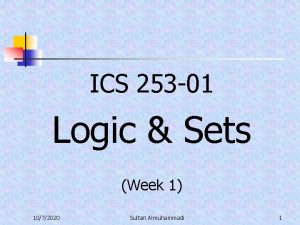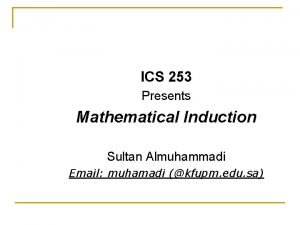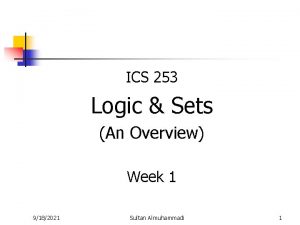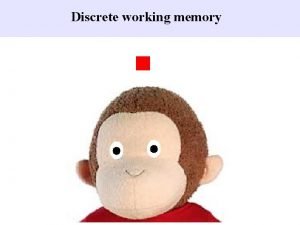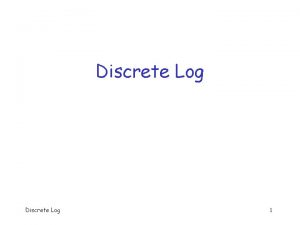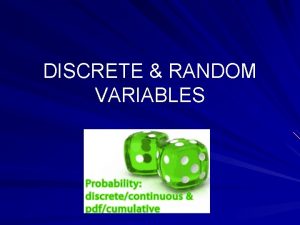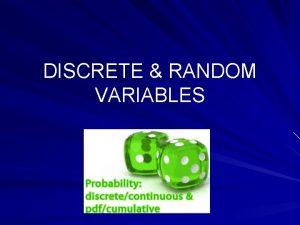ICS 253 Discrete Structures I Spring Semester 2014



![Tautology Example Demonstrate that [¬p (p q)] q is a tautology in two ways: Tautology Example Demonstrate that [¬p (p q)] q is a tautology in two ways:](https://slidetodoc.com/presentation_image_h/081a2580c181b96d5a9505762d39ddd8/image-4.jpg)













![Tautology Example - Part 2 Demonstrate that [¬p (p q )] q is a Tautology Example - Part 2 Demonstrate that [¬p (p q )] q is a](https://slidetodoc.com/presentation_image_h/081a2580c181b96d5a9505762d39ddd8/image-18.jpg)
![Tautology by proof [¬p (p q )] q [(¬p p) (¬p q)] q Distributive Tautology by proof [¬p (p q )] q [(¬p p) (¬p q)] q Distributive](https://slidetodoc.com/presentation_image_h/081a2580c181b96d5a9505762d39ddd8/image-19.jpg)

- Slides: 20

ICS 253: Discrete Structures I Spring Semester 2014 (2013 -2) Propositional Logical Equivalence Dr. Nasir Al-Darwish Computer Science Department King Fahd University of Petroleum and Minerals darwish@kfupm. edu. sa

Tautologies, contradictions, contingencies n A compound proposition is a tautology if it is always true no matter what truth values its atomic propositions have. q n The opposite to a tautology, is a compound proposition that’s always false – a contradiction. q n Example: p ¬p On the other hand, a compound proposition whose truth value isn’t constant is called a contingency. q Example: p ¬p KFUPM: Dr. Al-Darwish © 2014 1

Tautologies and contradictions The easiest way to see if a compound proposition is a tautology or a contradiction is to use a truth table. KFUPM: Dr. Al-Darwish © 2014 2
![Tautology Example Demonstrate that p p q q is a tautology in two ways Tautology Example Demonstrate that [¬p (p q)] q is a tautology in two ways:](https://slidetodoc.com/presentation_image_h/081a2580c181b96d5a9505762d39ddd8/image-4.jpg)
Tautology Example Demonstrate that [¬p (p q)] q is a tautology in two ways: 1. Using a truth table – show that [¬p (p q)] q is always true 2. Using a proof (will get to this later). Note: The LHS asserts (states) two facts: ¬p and (p q) Clearly, these assertions taken together imply q. KFUPM: Dr. Al-Darwish © 2014 3

Tautology Example - Part 1: by truth table p q ¬p (p q) [¬p (p q)] q F F T F T T T F T KFUPM: Dr. Al-Darwish © 2014 4

Tautologies, contradictions and programming Tautologies and contradictions in your code usually correspond to poor programming design. Examples: n n while(x <= 3 || x > 3) x++; if(x > y) if(x == y) return “never got here”; KFUPM: Dr. Al-Darwish © 2014 5

Logical Equivalence n Definition: Two compound propositions p, q are logically equivalent if their truth tables are the same. n Alternative Definition: Two compound propositions p, q are logically equivalent if their biconditional joining p q is a tautology. n Logical equivalence is denoted by p q or p q. q Example: A logical implication is equivalent to its contrapositive. That is, p q ¬q ¬p. KFUPM: Dr. Al-Darwish © 2014 6

Logical Equivalence - Example 1 The easiest way to test for logical equivalence is to check if the truth tables of both propositions have identical last columns Example: Is p q ¬q ¬p? p q p q T T F F T F T T T T F F T F ¬q F T ¬p F F T T ¬q ¬p T F T T Note that because the last columns are identical, it follows that (p q) (¬q ¬p) is a tautology, which is consistent with the second def. of equivalence in previous slide. KFUPM: Dr. Al-Darwish © 2014 7

Logical Equivalence - Example 2 n Show that ┐(p v q) and ┐p ˄ ┐ q are equivalent KFUPM: Dr. Al-Darwish © 2014 8

Logical Non-Equivalence of Conditional and Converse The converse of a logical implication is the reversal of the implication. I. e. the converse of p q is q p. Example: The converse of “If Donald is a duck then Donald is a bird. ” is “If Donald is a bird then Donald is a duck. ” As we’ll see next: p q and q p are not logically equivalent. KFUPM: Dr. Al-Darwish © 2014 9

Logical Non-Equivalence of Conditional and Converse p q T T F F T F p q q p T F T (p q) ( q p) T F F T Note that because the columns for p q and q p are not identical, we can immediately conclude that these propositions are not equivalent. KFUPM: Dr. Al-Darwish © 2014 10

Derivational Proof Techniques When a compound proposition involves many atomic components, the size of the truth table for the compound proposition becomes large Q 1: How many rows are required to construct the truth-table of: ((q (p r )) ( (s r) t) ) ( q r) ? Q 2: How many rows are required to construct the truth-table of a proposition involving n atomic components? A 1: 32 rows, each additional variable doubles the number of rows A 2: In general, 2 n rows Therefore, as compound propositions grow in complexity, truth tables become more and more unwieldy. In such cases, it is better to use derivational proof techniques KFUPM: Dr. Al-Darwish © 2014 11

Derivational Proof Techniques Example: consider the compound proposition (p p ) ( (s r) t) ) ( q r ) Q: Why is this a tautology? KFUPM: Dr. Al-Darwish © 2014 12

Derivational Proof Techniques Answer: The part (p p) is a tautology and the disjunction (or) of True with any other compound proposition always results in True: (p p ) ( (s r) t )) ( q r ) T ( (s r) t )) ( q r ) T Derivational techniques formalize the intuition of this example. KFUPM: Dr. Al-Darwish © 2014 13

Tables of Logical Equivalences n Identity laws Like adding 0 n Domination laws Like multiplying by 0 n Idempotent laws Delete redundancies n Double negation “I don’t like you, not” n Commutativity Like “x+y = y+x” n Associativity Like “(x+y)+z = y+(x+z)” n Distributivity Like “(x+y)z = xz+yz” KFUPM: Dr. Al-Darwish © 2014 14 14

Tables of Logical Equivalences n n n Excluded middle Negating creates opposite Definition of implication in terms of Not and Or KFUPM: Dr. Al-Darwish © 2014 15

De. Morgan Identities De. Morgan’s identities allow for simplification of negations of complex expressions n Conjunctional negation: (p 1 p 2 … pn) ( p 1 p 2 … pn) “It’s not the case that all are true iff one is false. ” n Disjunctional negation: (p 1 p 2 … pn) ( p 1 p 2 … pn) “It’s not the case that one is true iff all are false. ” KFUPM: Dr. Al-Darwish © 2014 16
![Tautology Example Part 2 Demonstrate that p p q q is a Tautology Example - Part 2 Demonstrate that [¬p (p q )] q is a](https://slidetodoc.com/presentation_image_h/081a2580c181b96d5a9505762d39ddd8/image-18.jpg)
Tautology Example - Part 2 Demonstrate that [¬p (p q )] q is a tautology in two ways: 1. Using a truth table (was done previously) 2. Using a proof relying on Tables 5 and 6 of Rosen, section 1. 3 to derive True through a series of logical equivalences KFUPM: Dr. Al-Darwish © 2014 17
![Tautology by proof p p q q p p p q q Distributive Tautology by proof [¬p (p q )] q [(¬p p) (¬p q)] q Distributive](https://slidetodoc.com/presentation_image_h/081a2580c181b96d5a9505762d39ddd8/image-19.jpg)
Tautology by proof [¬p (p q )] q [(¬p p) (¬p q)] q Distributive [ F (¬p q)] q ULE [¬p q ] q Identity ¬ [¬p q ] q ULE [¬(¬p) ¬q ] q De. Morgan [p ¬q ] q Double Negation p [¬q q ] Associative p [q ¬q ] Commutative p T ULE T Domination KFUPM: Dr. Al-Darwish © 2014 18

Important Equivalences 1. p q (p q) // meaning of 2. p q 3. p q q p 4. (p q) p q // negation of 1 5. (p q) (p r) p (q r) 6. (p q) (p r) p (q r) 7. (p r) (q r) (p q) r 8. (p r) (q r) (p q) r 9. p q (p q) (q p) 10. (p q) p q KFUPM: Dr. Al-Darwish © 2014 // simplify RHS of 1 // contrapositive 19
 Ics 253
Ics 253 Ics 253
Ics 253 Advanced incident management system
Advanced incident management system Hisd spring break 2014
Hisd spring break 2014 Proof by contradiction discrete math
Proof by contradiction discrete math Discrete structures
Discrete structures 2110200
2110200 Cs 584
Cs 584 Discrete structures
Discrete structures Discrete structures
Discrete structures Discrete computational structures
Discrete computational structures Spring summer fall winter and spring cast
Spring summer fall winter and spring cast Winter spring summer autumn months
Winter spring summer autumn months Psych 253
Psych 253 Chem 253
Chem 253 253 meaning in the bible
253 meaning in the bible Csc253 interactive multimedia
Csc253 interactive multimedia Detrusor leak point pressure
Detrusor leak point pressure National archives gb rail 253/516
National archives gb rail 253/516 Kibd-253
Kibd-253 Texes educational diagnostician 253
Texes educational diagnostician 253
